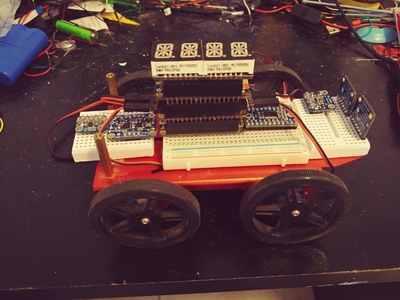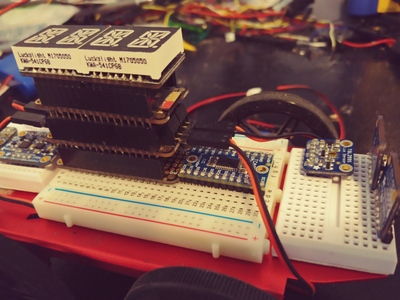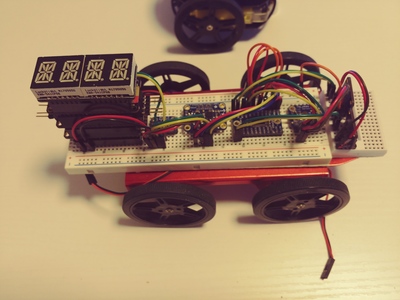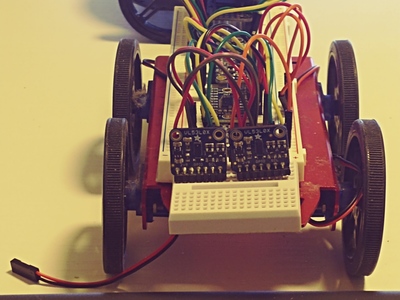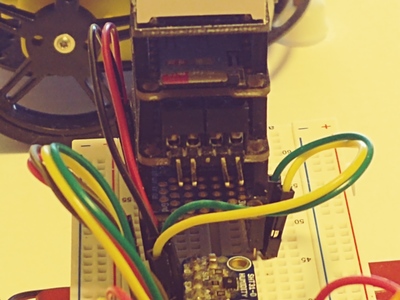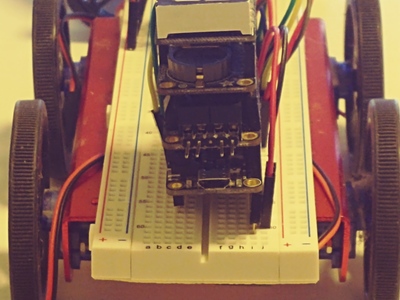Hi,
This is my Little Red Rover, made entirely from parts I bought from Adafruit. As you can see, I have stuffed quite a lot of sensors and peripherals on this little robot. I have the initialization and test code written and that all works perfectly. The robot can also log readings to the SD card on the AdaLogger Featherwing. All entries are date and time-stamped. I also have two scripts, one for the robot and one for my computer, which allows me to pull data from the robot to the computer.
The stack has (from the bottom up):
- Feather M4 Express (120 MHz, 192 Kb RAM)
- DC Motor Controller Featherwing
- AdaLogger Featherwing with RTC and SD card
- 0.54" Quad Alphanumeric Featherwing Display (Green)
The sensors, from left to right are:
- SHT31-D Temperature and Humidity sensor
- Precision NXP 9-DOF IMU - FXOS8700 + FXAS21002
- TCA9548A I2C Multiplexer
- TSL2591 High Dynamic Range Digital Light Sensor
- VL53L0X Time of Flight Distance Sensors - 30 to 1000 mm (2)
All the robot code is written in Adafruit's #Circuitpython. I have had all of this working on a single large breadboard with a #Circuitpython script that has all the initialization code and a testing section that reads everything from the sensors and prints it out. There is also code that creates data records in both JSON and comma-delimited formats and logs them to the SD card with date and time stamps. There are also two scripts, one for the robot and one for my computer (Python 3), which allows me to pull all the data from the robot.
I am going to swap the display for a 15x7 CharliePlex LED Matrix Display Featherwing (Green) because it is much easier to scroll text across the display, and I think that looks nicer. I also want to add an AirLift ESP32 WiFi Coprocessor Featherwing which will be on the bottom of the stack.
I can handle complexity. It is those simple things that confound me!
Hi,
I had to make some significant changes in the way I have my electronics breadboarded because using three breadboards was not working well. So, I am using only two breadboards now with most of the circuitry on one large breadboard. I also switched to using the premium jumpers instead of the old-style jumpers. These are worth every penny over the cost of the older jumpers! These jumpers also stay in the breadboard holes much better than the other ones, so they are much less likely to pop out of the holes when working on another part of the circuit.
This setup is much cleaner and easier to work on too! The order of the sensors has not changed. With the stack at the back end of the board, it is easier to get to the USB port of the Feather.
8-Dale
I can handle complexity. It is those simple things that confound me!
Nice work. I never heard of a Feather microcontroller before. There are so many boards available it's hard to keep up with them all. I just looked it up, it looks to be a pretty powerful little board.
DroneBot Workshop Robotics Engineer
James
Thank you. The Feather boards were designed by and are sold by Adafruit. The Feather board I am using here is a 120 MHz Cortex M4 with 192 Kb RAM and 512 Kb of flash. It can be used with the Arduino IDE, Circuitpython, or Makecode. Makecode is a web-based, block-oriented programming system. Circuitpython is derived from a fork of Micropython. They also have the 168 MHz Feather STM32F405 Express and one they are working on that runs at up to 600 MHz
8-Dale
I can handle complexity. It is those simple things that confound me!
Pretty powerful little boards. I've been using STM32F103 boards, both the Blue Pill and the Black Pill. They run at 72Mz and only have 64k memory. But so far these have been more than enough for my projects. I confess that the thing I like about them the most is the price. I get them for under $2 a piece. So I buy them in lots of 10 for under $20 a crack. ?
DroneBot Workshop Robotics Engineer
James


